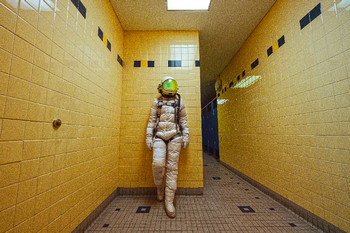
Karen Jerzyk is a photographer whose work is characterized by its haunting, otherworldly quality, transporting viewers into surreal environments where emotions, memories, and the subconscious collide. Her carefully curated images, featuring elaborate sets and dramatic lighting, offer more than aesthetic appeal; they are profound narratives that delve into themes of loss, isolation, resilience, and the human condition. To truly appreciate the depth of Jerzyk’s art, one must explore the symbolism, personal motivations, and the psychological resonance embedded in her creations.
Exploring Themes of Isolation and Vulnerability
At the heart of Jerzyk’s photography is a recurring exploration of solitude. Often, her subjects are placed in abandoned buildings, decaying rooms, or vast, desolate landscapes. These settings serve as metaphors for emotional isolation, reflecting the internal struggles many individuals experience but rarely express. By situating her models in these stark environments, Jerzyk externalizes the often hidden feelings of loneliness, inviting viewers to confront their own vulnerabilities. This isolation is not necessarily about physical loneliness but rather the emotional and existential isolation that is inherent to the human experience. Her subjects are often depicted as dreamlike or ethereal beings, caught in moments of contemplation or suspended in action. Their body language—hunched shoulders, upward gazes, outstretched arms—speaks to a yearning for connection or transcendence, which feels both deeply personal and universally relatable.
One of Jerzyk’s defining characteristics is her use of abandoned and decayed spaces as backdrops. These environments—defunct hospitals, crumbling mansions, or disused factories—are not just settings but integral characters in her stories. The physical decay of these spaces reflects themes of impermanence, loss, and the fragility of human existence. They are symbolic of the slow erosion that time inflicts on all things—our surroundings, our relationships, and even ourselves.
The absence of other human characters in many of her compositions heightens this sense of solitude. Even when props or traces of past lives (like old furniture or photographs) appear, they serve as reminders of loss rather than company. This interplay between presence and absence captures the paradox of modern life: how we can feel utterly alone even when surrounded by the remnants of others.
One notable series, "Last Days Of Earth", epitomizes this theme. The deserted and crumbling backdrops are juxtaposed with human subjects who appear fragile yet resilient. This contrast emphasizes the tension between the ephemeral nature of life and the enduring spirit of humanity. The decaying spaces act as stand-ins for psychological decay, while the presence of a solitary figure reminds us of the resilience needed to confront personal and societal disintegration.
The Surreal and the Subconscious
Jerzyk’s photography often incorporates surrealist elements that blur the line between dreams and reality. Her work draws on the visual language of surrealism, with motifs such as levitation, vibrant lighting, and symbolic props that suggest a deeper narrative. These elements are not mere visual flourishes; they are portals into the subconscious, urging viewers to explore their own psyche.
For instance, in many of her images, chairs float mid-air, vines entangle the furniture, or light pours in through cracks in unexpected ways. These symbolic disruptions challenge our perception of the ordinary, hinting at themes of escape, transcendence, and entrapment. The juxtaposition of the fantastical with the real mirrors the human experience of grappling with inner turmoil in a world that demands outward composure.
Personal Loss as Inspiration
Jerzyk’s work is deeply personal, often rooted in her own experiences of loss and grief. Following the death of her father, she began using her photography as a means of processing her emotions. This period of intense vulnerability became a creative turning point, infusing her images with an authenticity that resonates universally. Her art is not just a visual medium but a cathartic process, a way to channel the raw emotions of mourning into something tangible and meaningful.
Her ability to transform pain into beauty is one of the most compelling aspects of her work. Rather than shy away from uncomfortable emotions, Jerzyk leans into them, creating spaces where viewers can confront their own grief. This openness fosters a sense of shared humanity, making her work both deeply personal and profoundly communal.
Social Commentary and the Passage of Time
Beyond the personal, Jerzyk’s photography often serves as a commentary on societal issues. The abandoned settings she favors reflect a world in decay, a visual critique of neglect, consumerism, and the fleeting nature of human achievements. The emptiness of these spaces reminds us of our impermanence and the inevitability of change, encouraging introspection about our priorities and legacies.
Furthermore, the use of vintage props and settings in her work evokes a sense of nostalgia, inviting viewers to reflect on the passage of time. This temporal element underscores the fragility of life, urging us to appreciate the present while acknowledging the weight of the past.
Empowerment Through Visual Storytelling
While Jerzyk’s images often evoke melancholy, they are not devoid of hope. Her work empowers her subjects, often presenting them as resilient and self-possessed despite their surroundings. This strength becomes a rallying cry for viewers, reminding them of their own capacity for endurance and transformation.
Her characters are frequently depicted as dreamers, survivors, or seekers, navigating surreal worlds in search of meaning. This narrative arc transforms her images into more than static pieces of art; they become stories of human resilience and possibility, resonating on both personal and universal levels.
Conclusion
Karen Jerzyk’s work transcends the realm of photography to become a profound exploration of the human experience. Through her use of abandoned spaces, surreal elements, and deeply personal themes, she invites viewers into a world where vulnerability and resilience coexist. Her art challenges us to confront our own emotions, question societal norms, and find beauty in decay. It is this combination of the intimate and the universal, the real and the surreal, that makes her work so deeply impactful. In Jerzyk’s hauntingly beautiful images, we find not only the echoes of her personal journey but also a mirror reflecting our own.